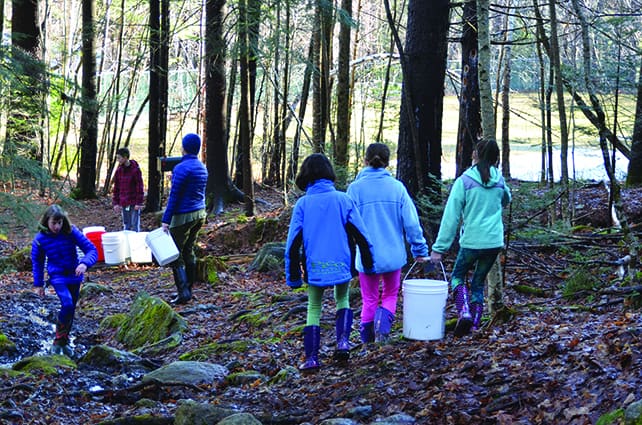Photos Courtesy of Robin Alberti
By Clara J. Shortle
Sugaring in the fourth grade is a lot of work, but it is also lots of fun. I know this because I am one of these fourth graders at Killington Elementary School.
The process is complicated, but I will try to explain it in the words that I understand. It is a great educational project full of surprises.
First, in the fall, you go and check the tubing lines, if you have plastic tubing, which our school does. Next, in the spring you get taps, buckets, a drill, lids for the buckets, hooks to hang the buckets from and a hammer. Then go up on a trail that has many maple trees. To tap, first you drill a hole that is about 1½ inch deep. Second, you attach the hook to the tap and gently tap it in with the hammer. Third, you hang the bucket from the hook. Finally, you put the lid on and let the sap run.
Then collect the sap every day or so until you have 20 gallons. Then boiling starts.
This is almost every fourth grader’s favorite part of sugaring.
To boil, your evaporator needs to be cleaned. To do this, boil water though it to clean it out from last year’s sap boiling. Then fill the oil tank if it needs to be filled. After the water has boiled through you start to put the sap in. First, though, you put on a filter. You pour sap into the pre-heat part of the evaporator until it is full. Once the sap in the pre-heat part has warmed to the proper temperature, you twist the valve to let the sap pour into the sections until it looks about the right height. Then you twist the valve so the sap just drips out of it. Next you measure the height of the sap in the evaporator with a dowel. If it is too high, you recycle the sap. The evaporator has a valve on the far side that you turn, holding a pan underneath it, and fill the pan half full. You return the partially boiled sap back to the beginning. Repeat this process every time the level gets too high. Also, add more sap as the sap condenses into syrup. Do this until it is very thick and is syrup.
The fourth graders can also tap trees at home and bring in sap to school for boiling. This is a very exciting part of the fourth grade.










